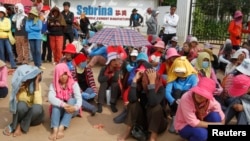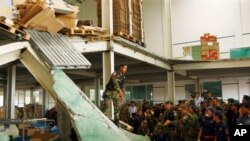PHNOM PENH —
Earlier this month two Cambodian garment workers died and more than 30 were injured when sections of two factories collapsed. The accidents came amid increased scrutiny of the global garment industry following the building collapse in Bangladesh that killed more than 1,100 workers. Factory owners in Cambodia are now under pressure to ensure the safety of their premises.
A letter went out this week to 500 garment and shoe-manufacturing factories in Cambodia advising them to hire inspectors to check the structural integrity of all their buildings.
The letter came from the U.N.’s International Labor Organization, the ILO, and the trade body GMAC, which represents factory owners. Through its Better Factories Cambodia program, the ILO monitors conditions at about 430 factories employing more than 400,000 workers.
Shoddy construction is being blamed for building collapses that killed two workers and injured dozens. The GMAC and the ILO told factory owners that worker safety and the industry’s integrity is at stake, and said it is in the industry’s interests to act now.
Jason Judd, a technical adviser with the ILO, says some factories have already agreed to the proposal.
"The leverage for change in these factories rests first with those buyers but ultimately with the Cambodian government. The buyers, they wield considerable influence over the factories. We think that factories that are really pushed by their buyers are more likely to go ahead with these inspections," said Judd.
Vital industry
Cambodia’s garment manufacturing industry is central to the economy, and is worth nearly $5 billion a year. It is by far the country’s largest export earner and its biggest formal employer. The three key stakeholders in Cambodia’s garment manufacturing industry are the government; the companies that own the factories - most of which come from China, Korea and Taiwan - and the buyers, including global brands such as Nike, Adidas and WalMart.
Dave Welsh, the country director at the American Center for International Labor Solidarity, a non-profit affiliated with the U.S.-based labor movement, cites a recent report by Better Factories Cambodia that found 14 percent of factories surveyed lock their fire exits, up from 1 percent two years ago. And 41 percent of factories do not bother to hold a fire drill every six months.
"You are dealing with in global terms a handful of factories and a very lucrative industry. So simply ensuring that fire escapes are in place, that the structures of those 400 export factories are up to international standards is well within the means of not just the government but the brands and the factories to do so. But as we saw by recent ILO findings, it seems that disasters are waiting to happen. And now is the time," he said.
Ken Loo, the secretary-general of the trade body GMAC, says most of his members will follow GMAC’s advice and get their buildings checked in due course.
“It’s not about when factories need to do it by - it’s more like, look this is an area that if you are a member you should be concerned about - and therefore they should pay attention," he said.
Enforcement issue
In February the ILO’s Better Factories Cambodia program itself came under criticism on the grounds that it lacks transparency and cannot enforce its findings.
Speaking via Skype, Ben Hensler, the deputy director of the Workers’ Rights Consortium, said the ILO made a mistake when in 2006 it agreed not to publicize its findings.
“Because we think that the only way that conditions improve is through having some transparency and for factories and buyers to know that if they're not meeting standards of keeping workers safe that the public is going to know about that and their reputations are going to be affected," Hensler said.
The ILO's Jason Judd said the group recognizes the need for change and plans to roll out a revised program later this year.
“We’re still working on the details, but public disclosure is going to be targeted so that it drives improvements in factories that are really chronic violators of the law, and also helps drive improvements on issues like fire safety," he said.
But Judd stressed that the responsibility for success ultimately lies with those who have the power to make those changes: the factories, the brands and the Cambodian government.
VOA Bangkok Correspondent Daniel Schearf contributed to this report.
A letter went out this week to 500 garment and shoe-manufacturing factories in Cambodia advising them to hire inspectors to check the structural integrity of all their buildings.
The letter came from the U.N.’s International Labor Organization, the ILO, and the trade body GMAC, which represents factory owners. Through its Better Factories Cambodia program, the ILO monitors conditions at about 430 factories employing more than 400,000 workers.
Shoddy construction is being blamed for building collapses that killed two workers and injured dozens. The GMAC and the ILO told factory owners that worker safety and the industry’s integrity is at stake, and said it is in the industry’s interests to act now.
Jason Judd, a technical adviser with the ILO, says some factories have already agreed to the proposal.
"The leverage for change in these factories rests first with those buyers but ultimately with the Cambodian government. The buyers, they wield considerable influence over the factories. We think that factories that are really pushed by their buyers are more likely to go ahead with these inspections," said Judd.
Vital industry
Cambodia’s garment manufacturing industry is central to the economy, and is worth nearly $5 billion a year. It is by far the country’s largest export earner and its biggest formal employer. The three key stakeholders in Cambodia’s garment manufacturing industry are the government; the companies that own the factories - most of which come from China, Korea and Taiwan - and the buyers, including global brands such as Nike, Adidas and WalMart.
Dave Welsh, the country director at the American Center for International Labor Solidarity, a non-profit affiliated with the U.S.-based labor movement, cites a recent report by Better Factories Cambodia that found 14 percent of factories surveyed lock their fire exits, up from 1 percent two years ago. And 41 percent of factories do not bother to hold a fire drill every six months.
"You are dealing with in global terms a handful of factories and a very lucrative industry. So simply ensuring that fire escapes are in place, that the structures of those 400 export factories are up to international standards is well within the means of not just the government but the brands and the factories to do so. But as we saw by recent ILO findings, it seems that disasters are waiting to happen. And now is the time," he said.
Ken Loo, the secretary-general of the trade body GMAC, says most of his members will follow GMAC’s advice and get their buildings checked in due course.
“It’s not about when factories need to do it by - it’s more like, look this is an area that if you are a member you should be concerned about - and therefore they should pay attention," he said.
Enforcement issue
In February the ILO’s Better Factories Cambodia program itself came under criticism on the grounds that it lacks transparency and cannot enforce its findings.
Speaking via Skype, Ben Hensler, the deputy director of the Workers’ Rights Consortium, said the ILO made a mistake when in 2006 it agreed not to publicize its findings.
“Because we think that the only way that conditions improve is through having some transparency and for factories and buyers to know that if they're not meeting standards of keeping workers safe that the public is going to know about that and their reputations are going to be affected," Hensler said.
The ILO's Jason Judd said the group recognizes the need for change and plans to roll out a revised program later this year.
“We’re still working on the details, but public disclosure is going to be targeted so that it drives improvements in factories that are really chronic violators of the law, and also helps drive improvements on issues like fire safety," he said.
But Judd stressed that the responsibility for success ultimately lies with those who have the power to make those changes: the factories, the brands and the Cambodian government.
VOA Bangkok Correspondent Daniel Schearf contributed to this report.












